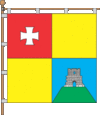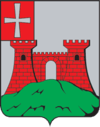Kremenets
| Kremenets Крем'янець, Кременець | |||
|---|---|---|---|
| City of regional significance | |||
|
Kremenets panorama from the Castle Hill | |||
| |||
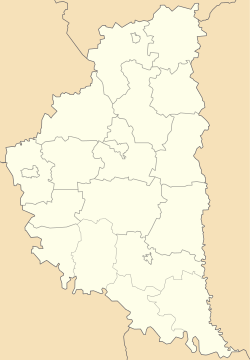 Kremenets Kremenets in Ternopil Oblast | |||
| Coordinates: UA 50°07′11″N 25°43′00″E / 50.11972°N 25.71667°ECoordinates: UA 50°07′11″N 25°43′00″E / 50.11972°N 25.71667°E | |||
| Country |
| ||
| Oblast | Ternopil Oblast | ||
| Raion | Kremenets Raion | ||
| Area | |||
| • Total | 20.76 km2 (8.02 sq mi) | ||
| Population (2001) | |||
| • Total | 21,880 | ||
| • Density | 1,100/km2 (2,700/sq mi) | ||
| Time zone | UTC+2 | ||
| • Summer (DST) | UTC+3 (UTC) | ||

Kremenets (Ukrainian: Крем'янець, Кременець, translit. Kremenets, Polish: Krzemieniec) is a city of regional significance[1] in the Ternopil Oblast (province) of western Ukraine. It is the administrative center of the Kremenets Raion (district), and rests 18 km north-east of the great Pochayiv Monastery. The city is situated in the historic region of Volhynia.
History
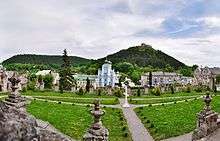
According to some sources the Kremenets fortress was built in the 8th or 9th century, and later became a part of Kievan Rus’. The first documented reference to the fortress is given in a Polish encyclopedic dictionary written in 1064. The first reference to Kremenets in Old Slavic literature dates from 1226 when the city's ruler, Mstislav the Bold, defeated the Hungarian army of King Andrew II nearby. During the Mongol invasion of Rus in 1240-41, Kremenets was one of few cities that Batu Khan failed to capture. In 1382, after the death of Louis I of Hungary, Lithuanian duke Liubartas captured Kremenets from the Kingdom of Hungary. The city obtained Magdeburg rights in 1431, and in 1569, after the Union of Lublin, it became part of Crown of Poland, known as Polish: Krzemieniec.
In the fall of 1648 Cossack Colonel Maxym Kryvonis surrounded the Kremenets fortress. In October, after a six-week siege, the royal garrison surrendered. As a consequence of the fighting, the fortress was severely damaged and was never rebuilt. In 1795 Kremenets was annexed by the Russian Empire following the Third Partition of the Polish-Lithuanian Commonwealth. It remained a part of Russia until World War I.
During 1917-1920 Kremenets 7 times passed from hand to hand. The authorities Ukrainian state - Ukrainian People's Republic - it was subject to early 1918 to June 1919.
In 1921, following Peace of Riga, the town returned to Poland, and was part of Volhynian Voivodeship.
In the interwar period, Kremenets was famous for its renowned high school, Liceum Krzemienieckie, founded in 1803 by Tadeusz Czacki. According to the 1931 Polish census, the town had a population of 19,877, with 8,428 Ukrainians, 6,904 Jews, 3,108 Poles and 883 Russians. In 1934, upon initiative of Ludwik Gronowski, teacher of the Kremenets High School, Volhynian School of Gliding Sokola Góra (Wołyńska Szkoła Szybowcowa Sokola Góra) was opened 14 kilometers from Kremenets, in the village of Kulików. Among its students was the daughter of Jozef Piłsudski, Jadwiga Piłsudska.
On July 28, 1941, most of the teachers of the Krzemieniec High School were arrested by the Germans, who used a list provided to them by local Ukrainians. By the end of the month, 30 teachers and members of Polish intelligentsia were murdered at the so-called Hill of Crosses (Góra Krzyżów).
During the restoration of Ukrainian statehood in 1991, was restored Kremenets Botanical Garden (1991), created Kremenetsko-Pochaivskiy State Historical-Architectural Reserve (2001), opened Kremenetskiy Regional Humanitarian Pedagogical Institute n. Shevchenko (2002), Kremenetskiy Regional Museum Juliusz Slowacki (2003), increasing the flow of tourists. In 1991 at the Teachers College Shevchenko created a modern Kremenets Lyceum.
Jews of Kremenets
Jews are known to have settled in the Kremenets area as early as 1438,[2] when the Grand Duke of Lithuania gave them a charter. However, in 1495, Lithuania expelled its Jews until 1503. A Polish Yeshiva, however, operated in Kremenets during the 15th and 16th centuries.[3]
The Jewish community expanded and prospered through the 16th century. Around the middle of the century, rabbinical representatives of the Kahals of Poland began gathering at the great Fairs to conduct the business of the Jewish communities. These conferences became known as the Council of the Four Lands. Volhynian representatives were from Ostroh and Kremenets.[4]
Khmelnytsky’s Cossack uprising against the Polish land owners from 1648 through 1651, followed by the Russian-Swedish wars against Poland-Lithuania from 1654-1656, devastated the Jewish population of western Ukraine. Many Jews, many of which were stewards magnates, were murdered, while others fled. Jews were not allowed to rebuild their destroyed homes. Kremenets never again regained its former importance. All that was left as the Russians took control in 1793 was “an impoverished community of petty traders and craftsmen.”[5]
In 1747, Kremenets was the site of a well-publicized blood libel trial in which 14 Jews were accused of murdering a Christian to obtain blood for making matzo – a false accusation dating back to the Middle Ages. The incident began when an unidentified corpse was found near an inn and curious townsfolk gathered around to view the body. When some Jews joined the crowd, the corpse supposedly began to bleed, thus supernaturally demonstrating their guilt. Twelve of the Jews confessed under torture (placed on the rack and burned with red-hot irons). Most were gruesomely executed by being flayed, quartered and impaled while still alive, by orders of the Christian civil authorities.[6]
Jewish life gradually revived and Kremenets became a secondary center of Haskalah (enlightenment) in Eastern Europe in the period 1772 through 1781.[7] By the end of the 19th century, Jews once again were active in the economic life of the town, primarily in the paper industry and as cobblers and carpenters. They exported their goods to other towns in Russia and Poland.[8] Under Polish rule, in the early 1930s, two Yiddish periodicals were published. They merged in 1933 into a single weekly newspaper, Kremenitser Lebn (Kremenets Life).[8]
Holocaust
The Nazis destroyed the Jewish community of Kremenets. Except for those who left Kremenets before the war and 14 survivors, all 15,000 Jews who lived in Kremenets in 1941 were murdered.
The Soviet authorities annexed the town on September 22, 1939. In the spring of 1940, the refugees from western Poland were obliged to register with the authorities and to declare whether they wished to take up Soviet citizenship or return to their former homes, now under German occupation. Jewish communal life was forbidden, and Zionist leaders were forced to move to other cities to keep their past activities from the knowledge of the authorities. By 1941 the Jewish population had increased to over 15,000 including over 4,000 refugees.[9]
In June 1941, the German Einsatzgruppe “C” carried out a mass slaughter of Jews in the Generalbezirk Wolhynien-Podolien District, which was part of Reichskommissariat Ukraine. The District included all of Volhynia.
“A few days after the German-Soviet war broke out (June 22, 1941) the Germans reached the area. Hundreds of young Jews managed to flee to the Soviet Union. A pogrom broke out in early July 1941, where 800 men, women and children were killed. In August 1941 the Gestapo ordered all Jews with academic status to report for registration. All those who did so were murdered, and the Jewish community's leadership was destroyed. That month the Germans set fire to the main synagogue and exacted a fine of 11 kg. of gold from the community.
A Judenrat was imposed. The head, Benjamin Katz was murdered for his refusal to collaborate with the Nazis. At the end of January 1942 a ghetto was established and on March 1 was closed off from the rest of the city. The inmates endured great hardship and there was a serious shortage of water.[10]
In the summer of 1942, the Germans began the systematic liquidation of the ghettos in the provincial towns. In some of them revolts broke out, the ghetto inmates resisting their deportation, setting the ghetto houses on fire and making mass attempts to escape to the forests. Nesvizh, Mir, Lachva, Kletsk, and Kremenets were some of the places where ghetto revolts occurred.[11]
On July 22, 1942, there was armed resistance by the Jews of the Kremenets ghetto against the Germans, who were trying to exterminate them.[12] The Kremenets ghetto's lasted for two weeks, and 19,000 Jews were murdered.[13]
On August 10, 1942, the Germans initiated a two-week-long Aktion to annihilate the inmates, setting the ghetto ablaze to drive out those in hiding. Fifteen hundred able-bodied persons were dispatched as slave laborers to Bilokrynytsia, where they later met their death. The vast majority of the ghetto inhabitants rounded up in the Aktion were taken in groups and murdered over trenches dug near the railway station, near a former army camp. The local Zionist leader Benjamin Landsberg committed suicide. Only 14 of the Kremenets community survived the Holocaust. Societies of former residents of Kremenets function in Israel, the United States and Argentina.[9]
Although the Jewish presence in Kremenets was physically destroyed, the memory of Jewish Kremenetsers lived on. In the postwar years, those who successfully emigrated before the onset of hostilities, survivors of the Holocaust, and their descendants published two Yizkor Books and a series of memorial Bulletins.
Economy
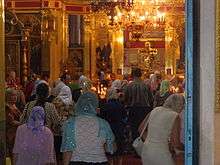
Today the economy of Kremenets is supported by Orthodox pilgrims who come to visit the cathedrals, the nunnery, and the nearby Pochayiv Lavra as well as by Polish tourists visiting the Juliusz Słowacki museum. The museum was opened in 2002, with financial help of the government of Poland, which provided one million dollars for the project. There is also a large sugar refinery, but the plant was closed during the financial crisis of 2007–2010.
Points of interest
- complex of a former Jesuit college, which housed the Krzemieniec Lyceum. Designed by Jesuit architect Paweł Gizycki, and founded by the Wisniowiecki family, it was built in 1731-1753, and among others, consists of Ignatius of Loyola Roman Catholic church,
- Stanislaus of Szczepanow Roman Catholic church, built in 1853-1857, with a monument of Juliusz Slowacki inside. In Soviet Union, it served as a gym, currently it belongs to Ukrainian Orthodox Church,
- female Orthodox monastery, which continues the traditions of a 1636 monastery. In the Second Polish Republic, it was the seat of Orthodox Volhynian Bishops.
Kremenets Botanical Garden
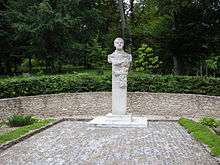
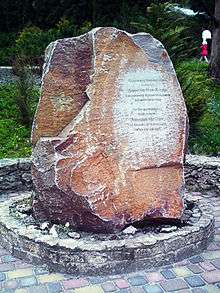
Kremenets Botanical Garden (Ukrainian: Кременецький ботанічний сад) was founded in 1806, making it one of the oldest botanical gardens in the country. A resolution of the Cabinet of Ministers of Ukraine from October 12, 1992 declared the Kremenets Botanical Garden as a protected area of national importance, which aims are to preserve, study, acclimate rare and common flora.
Botanical Garden's area has 200 hectares, most of which - natural landscapes of complex topography with a height difference of 150 meters (maximum absolute height ois the territory of 399 meters, minimum - 255 m). 170 hectares of the territory consist of artificial and natural forest plantations, herbaceous and rock communities. The slopes of the garden covered with hornbeam, oak - hornbeam, larch, pine, pine-birch, ash-maple forests of artificial and natural origin.
History
During 1806-1809 project of Kremenets'kiy Botanical Garden had been formed by famous Irish master of landscape architecture Dionysius Mc Klyer. According to this project garden area was 4.5 hectares. It consisted of the park, rose garden, three orangeries, greenhouses and pharmacist garden. Collected by D. Mc Klyerom collection of living plants totaled 480 species of local flora and 760 exotic plants. The contribution of an Irishman was something that Grain Land Ukraine did not want to let dissipate. To sustain this Irish link and to protect a two-century-old work, Grain Land Ukraine financed a new Irish Corner in the garden. The Irish Corner is planted with plants and trees native to Ireland.[14]
In 1809, the director of the garden became doctor of medicine, botany and zoology, Austrian Wilibald Swibert Joseph Gottlieb von Besser. The area extends to 20 hectares and number of species increased to 1200. In 1810 W. Besser published the first catalog of plants of botanical garden, which describes the interesting species brought from France, Switzerland, Germany, Belgium, the U.S. and other countries. This catalog include such species as: Canadian pine, Rhododendron anthopogon, Liriodendron tulipifera, Ginkgo biloba, Morus alba, Castanea sativa. Many species was transferred to the botanical garden from private collections and gardens. W. Besser widely practiced exchange seeds and herbarium with the botanic gardens of Kraków, Hamburg, Paris, Hetinhen, Vienna and others. became famous as a result of systematic publications V. Besser.A clear indication of species richness and uniqueness of the collection of living plants of Kremenets’kiy Botanical Garden was the presence of 241 plant species from Cape floral kingdom in it.
In 1832, the Kremenets Botanical Garden was closed. The main collector base was moved to Kyiv,where it formed University of St. Vladimir (now Taras Shevchenko National University of Kyiv) and botanical garden with it (now The Fomin Botanical Garden). In 1921-1939 and 1951-1969 attempts were made to open the garden. In 1990 according to the Council of Ministers of Ukraine botanical garden was restored. Since 2001, the garden transferred into submission of the Ministry of Ecology and Natural Resources of Ukraine.
Collection
Сollection fund of botanic Garden has over 2000 taxa. The collection of trees and shrubs contains 217 species; medicinal - 111 species; fodder plants - 128 species of 29 genders; vegetable - 74 species of 8 genders; flower-ornamental - 220 species of 84 genders,fruit and berry - 66 species, 141 genders. In collection there are 270 species of the natural flora plants, including 11 listed in the Ukrainian Red book: Neottia nidus-avis (L.) Rich, E. purpurata Smith, Cephalanthera damasonium (Mill.) Druce from the family Orchidaceae, Galanthus nivalis L. from family Amary daceae, Lilium martagon L. from family Liliaceae, Allium ursinum L, Epipactis atrorubens (Hoffm. ex Bernb.) Schult., on the lighter areas occurs A. strictum Schrad, the family AIIiaseae, Botrychium lunaria (L.) Sw. family Lycopodiaceae. Common area is for relics: Melittis sarmatica Klok. the family Lamiaceae, Hedera helix L. the family Araliaceae, grows here and Daphne mezereum L. the family Thymelaeaceae.
Currently, the Botanical Garden has 5 scientific departments: Dendrology, Phytosozology, Department of flower-ornamental plants, Department of acclimatization of fruit crops, Medicinal plants and new plants cultivation department.
People from Kremenets
Ukrainian
- Oleksander Osetsky — a general in the army of the Ukrainian People's Republic (UNR),
- Andriy Pushkar — an armwrestler, World champion
- Vitaliy Shumbarets — World cup ski jumper.
Poles
- Jozef Antoni Beaupre — Polish physician and patriotic activist, graduate of the Krzemieniec high school,
- Tadeusz Czacki — social activist, historian, born in nearby Poryck, founder of the Krzemieniec Lyceum,
- Aleksander Czekanowski — Polish geologist and explorer of Siberia,
- Joanna Duda-Gwiazda — oppositional activist in Communist Poland, wife of Andrzej Gwiazda,
- Pawel Gizycki — Polish Baroque era architect, painter, Jesuit priest,
- Jerzy Litwiniuk — Polish poet and translator,
- Zygmunt Rumel — Polish poet and resistance fighter, murdered by Ukrainian nationalists on July 10, 1943,
- Irena Sandecka — Polish poet, social activist and teacher,
- Juliusz Słowacki — Polish romantic poet,
- Salomea Slowacka — mother of Juliusz Slowacki, buried at the local cemetery,
- Kazimierz Urbanik — mathematician, rector of Wroclaw University.
Jews
- Mark Kac — mathematical physicist,
- Isaac Stern – violin virtuoso.
References
- ↑ (Ukrainian) Infos on radyvyliv.info
- ↑ Simon Wiesenthal
- ↑ Barnavi, p. 143.
- ↑ Dubnow, vol. I, pp. 109–110.
- ↑ Simon Wiesenthal, Encyclopedia Judaica
- ↑ Infos at kehilalinks.jewishgen.org
- ↑ Barnavi, p. 177.
- 1 2 Encyclopedia Judaica
- 1 2 Encyclopedia Judaica.
- ↑ Encyclopedia Judaica
- ↑ Heritage Films “
- ↑ JewishGen: Holocaust
- ↑ Heritage Films, Poland
- ↑ "Case Study: Kremenets Botanical Garden". Grain Land Ukraine LLC. Retrieved 12 July 2013.
External links
| Wikimedia Commons has media related to Kremenets. |
- Illustrated guide of Krzemieniec, published in Lutsk in 1929
- Volodymyr Kubijovyč, Kremenets in Encyclopedia of Ukraine, vol. 2 (1989). (English) (Encyclopedia of Ukraine)
